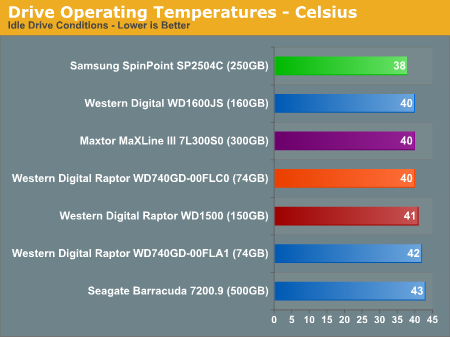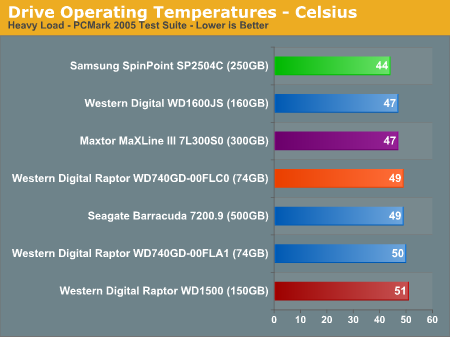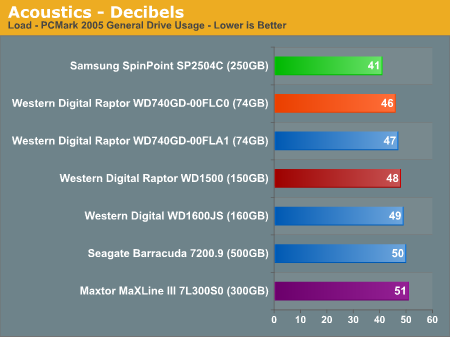Western Digital WD1500ADFD: King Raptor
by Gary Key on February 8, 2006 1:30 AM EST- Posted in
- Storage
Hard Drive Performance: Thermal and Acoustics
We have revised our acoustics testing for this article. Our acoustic test utilizes our standard test bed components, but we installed our Thermaltake water-cooling system for the CPU and turned off the case fans to isolate as much case noise as possible during testing. Our OCZ power supply is virtually silent in these tests and we installed our fanless Gigabyte 6600GT video card to further reduce noise.
Our acoustic tests are designed to measure the decibel levels while the system is at idle and also under load while running the General Hard Disk Drive Usage benchmark within PCMark 2005. We found through trial and error that this particular benchmark produces controlled readings across a wide range of applications within the benchmark. This particular benchmark utilizes 60% reads and 40% writes within the trace playback file.
The measurements are taken at a distance of 5 millimeters from the rear and front of the drive being tested in order to minimize surrounding environmental noise. The reported measurements are based on an A-weighted decibel score that measures frequencies similar to the way that the human ear responds to sound. We take a total of 5 measurements for each test. We subtract the high and low scores and then average the middle three to arrive at our findings.
Our thermal tests continue to utilize sensor readings via the S.M.A.R.T. technology on the drives. We will move to an infrared thermometer testing procedure in the near future to supplement the current test procedures.
The thermal characteristics of both Raptors were very close with the WD1500 running slightly hotter under the load conditions. While we did not report the infrared test results in this article, the heat sink fan area on the Raptors reached temperatures around 55c during the load testing. Of course, these temperatures would be reduced with the case fans running, but it is something to be aware of if you plan on utilizing the drive in a SFF case.
The acoustical characteristics of both Raptors were similar. You will notice a slight whine during the spin-up phase on each drive along with the same whine when the drive powers down. The reads are clearly audible, but do not have the same metallic noise that we noticed on the Maxtor drives. During normal operations, both drives could be heard, but the sounds emitting from the drive was almost dull compared to the Maxtor drives. The WD1500 was slightly louder during constant read access compared to the WD740GD. While not obtrusive in our opinion, the sound levels would be clearly evident in a silent system.
We have revised our acoustics testing for this article. Our acoustic test utilizes our standard test bed components, but we installed our Thermaltake water-cooling system for the CPU and turned off the case fans to isolate as much case noise as possible during testing. Our OCZ power supply is virtually silent in these tests and we installed our fanless Gigabyte 6600GT video card to further reduce noise.
Our acoustic tests are designed to measure the decibel levels while the system is at idle and also under load while running the General Hard Disk Drive Usage benchmark within PCMark 2005. We found through trial and error that this particular benchmark produces controlled readings across a wide range of applications within the benchmark. This particular benchmark utilizes 60% reads and 40% writes within the trace playback file.
The measurements are taken at a distance of 5 millimeters from the rear and front of the drive being tested in order to minimize surrounding environmental noise. The reported measurements are based on an A-weighted decibel score that measures frequencies similar to the way that the human ear responds to sound. We take a total of 5 measurements for each test. We subtract the high and low scores and then average the middle three to arrive at our findings.
Our thermal tests continue to utilize sensor readings via the S.M.A.R.T. technology on the drives. We will move to an infrared thermometer testing procedure in the near future to supplement the current test procedures.




The thermal characteristics of both Raptors were very close with the WD1500 running slightly hotter under the load conditions. While we did not report the infrared test results in this article, the heat sink fan area on the Raptors reached temperatures around 55c during the load testing. Of course, these temperatures would be reduced with the case fans running, but it is something to be aware of if you plan on utilizing the drive in a SFF case.
The acoustical characteristics of both Raptors were similar. You will notice a slight whine during the spin-up phase on each drive along with the same whine when the drive powers down. The reads are clearly audible, but do not have the same metallic noise that we noticed on the Maxtor drives. During normal operations, both drives could be heard, but the sounds emitting from the drive was almost dull compared to the Maxtor drives. The WD1500 was slightly louder during constant read access compared to the WD740GD. While not obtrusive in our opinion, the sound levels would be clearly evident in a silent system.










51 Comments
View All Comments
jamescleant - Wednesday, February 8, 2006 - link
I noticed you revised your acoustic testing, but this leads to a different ranking when compared to the one in the article :"Seagate 7200.9 160GB: The Highest Platter Density to Date!"
http://anandtech.com/storage/showdoc.aspx?i=2682&a...">http://anandtech.com/storage/showdoc.aspx?i=2682&a...
In the article mentionned above, the idle noise of the 500 GB 7200.9 is lower than the idle noise of the 74 GB Raptor, and in this article, it is the contrary.
What is the explanation of this ?
Also, did you test the acoustics of the Samsung SP2504C with the "old" method ? I am interested by the comparison with other models (I try to have the most silent drives).
Gary Key - Wednesday, February 8, 2006 - link
I will detail a response tonight and test the SP2504c with the old standard.Gary Key - Wednesday, February 8, 2006 - link
I am still working on providing the old numbers. I did locate the original sound meter used and will have it here tomorrow.noxipoo - Wednesday, February 8, 2006 - link
3 seagate 7200.9 in raid 0 vs 1 raptor? about the same price point, would be interesting.mlittl3 - Wednesday, February 8, 2006 - link
See my post above. Gamepc did 4 rapters in raid 0 versus scsi and P-ATA drive.sxpose - Wednesday, February 8, 2006 - link
Id like to see some raided drive scores as well. Because this drive is marketed at enthusists . . . good chance some will just buy two and raid them. Majority of the readers don't have scsi drives, so not sure why you'd choose those benchmarks over some consumer raided drives.mlittl3 - Wednesday, February 8, 2006 - link
See my post above for raid tests.Orbs - Wednesday, February 8, 2006 - link
First of all, another great article, AT!So RAID was debated in the comments of the last HDD article AT posted, and while traditionally RAID hasn't shown much of a performance improvement, the fact that nearly all enthusiast motherboards now come with some sort of RAID controller and since the Raptors now use a native Serial ATA interface, the story might have changed.
Can AT do a RAID shootout or something? I would be very interested in something like that.
Again, great article!
Gary Key - Wednesday, February 8, 2006 - link
We will have updated benchmarks or a new article with RAID results for this drive and others in the near future. Thank you.Zebo - Saturday, February 11, 2006 - link
Waste of time but I guess when the RAID freaks demand it they get it.